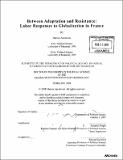| dc.contributor.advisor | Suzanne Berger. | en_US |
| dc.contributor.author | Ancelovici, Marcos, 1971- | en_US |
| dc.contributor.other | Massachusetts Institute of Technology. Dept. of Political Science. | en_US |
| dc.coverage.spatial | e-fr--- | en_US |
| dc.date.accessioned | 2009-08-26T17:14:03Z | |
| dc.date.available | 2009-08-26T17:14:03Z | |
| dc.date.copyright | 2008 | en_US |
| dc.date.issued | 2008 | en_US |
| dc.identifier.uri | http://hdl.handle.net/1721.1/46656 | |
| dc.description | Thesis (Ph. D.)--Massachusetts Institute of Technology, Dept. of Political Science, 2008. | en_US |
| dc.description | Includes bibliographical references (p. 267-289). | en_US |
| dc.description.abstract | This dissertation aims at accounting for labor responses to globalization in France. It addresses this issue through a comparative study of two labor organizations-the French Democratic Labor Confederation (CFDT) and the General Confederation of Labor (CGT)-that today respond differently to globalization even though they held common positions in the past: while the CGT opposes globalization, the CFDT sees it as an opportunity for French workers. I call the former response the resistance strategy and the latter the adaptation strategy. This dissertation claims that responses to globalization are formed and transformed over time as the environment of organizations changes and intraorganizational struggles unfold. More specifically, it argues that in France the formation of labor responses to globalization stemmed from a path dependent process constituted by three different steps. First, organizational failure, illustrated by union decline, implied a critical juncture that fed intraorganizational struggles and opened the way for a reorientation of labor organizations. Second, once the crisis was acknowledged, whether organizations would take the path to adaptation or resistance depended on three factors: (1) resources inherited from the past that limit the range of options that actors can conceive and choose; (2) the presence and content of two mechanisms of change-bricolage and identity shift-that describe how actors used their inherited resources; and (3) the ability of leaders to articulate a narrative that would appeal to enough people inside their organizations so as to induce cooperation. The third and last step of this path dependent process refers to the stabilization of the new path that the CFDT and the CGT had taken. The central mechanism that stabilized these paths was a shift in the organizational opportunity structure. Although labor organizations were not completely locked in the new path, once the organizational opportunity structure had shifted it was very difficult to return to the previous path or engage in a substantially different one. | en_US |
| dc.description.abstract | (cont.) Therefore, unless another critical juncture takes place, the CFDT and the CGT are likely to stick with their current responses to globalization for many years. | en_US |
| dc.description.statementofresponsibility | by Marcos Ancelovici. | en_US |
| dc.format.extent | 289 p. | en_US |
| dc.language.iso | eng | en_US |
| dc.publisher | Massachusetts Institute of Technology | en_US |
| dc.rights | M.I.T. theses are protected by
copyright. They may be viewed from this source for any purpose, but
reproduction or distribution in any format is prohibited without written
permission. See provided URL for inquiries about permission. | en_US |
| dc.rights.uri | http://dspace.mit.edu/handle/1721.1/7582 | en_US |
| dc.subject | Political Science. | en_US |
| dc.title | Between adaptation and resistance : labor responses to globalization in France | en_US |
| dc.type | Thesis | en_US |
| dc.description.degree | Ph.D. | en_US |
| dc.contributor.department | Massachusetts Institute of Technology. Department of Political Science | |
| dc.identifier.oclc | 427059338 | en_US |

